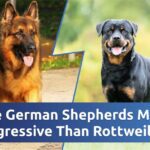German Shepherds are known for their intelligence, loyalty, and versatility. Their coats come in three main types: short, medium, and long. Short coats are dense and close to the body, providing a sleek appearance. Medium coats have a bit more length and are slightly wavy or straight.
Long coats are the most distinctive, featuring flowing hair that requires regular grooming. Each coat type offers unique benefits and challenges.
Understanding these coat types helps in choosing the right German Shepherd for your lifestyle. Proper care and grooming ensure your German Shepherd remains healthy and comfortable.
Overview Of German Shepherd Coat Types
German Shepherds are known for their loyalty, intelligence, and versatile working abilities. One of the fascinating aspects of this breed is their diverse coat types.
Understanding the different coat types helps in grooming, maintenance, and appreciating the breed’s beauty. This blog post provides an overview of the various German Shepherd coat types.
Different Coat Lengths: Short, Medium, And Long
German Shepherds can have three primary coat lengths: short, medium, and long. Each coat length has unique characteristics and maintenance needs.
Short Coat:
Medium Coat:
Long Coat:
Variations Within Each Coat Type
Each coat length can have several variations that add to the breed’s diversity.
Short Coat Variations:
Medium Coat Variations:
Long Coat Variations:
Understanding these variations helps in choosing the right grooming techniques and appreciating the unique beauty of each German Shepherd.
Understanding The Double Coat
German Shepherds are known for their intelligence and versatility. One key feature that sets them apart is their coat.
Understanding the types of German Shepherd coats, especially the double coat, is essential for proper grooming and care. This section delves deep into the fascinating world of the double coat.
The double coat of a German Shepherd consists of two distinct layers. The outer coat or guard coat is dense and water-resistant.
This layer protects the dog from harsh weather and dirt. The undercoat is soft and fluffy, providing insulation and warmth.
The Outer Coat
The outer coat is composed of long, straight hairs that lie close to the body. These hairs are somewhat stiff and provide a barrier against rain and snow. The outer coat also helps to keep dirt and debris away from the skin.
The Undercoat
The undercoat is the German Shepherd’s secret weapon against cold temperatures. This layer is thicker and softer than the outer coat. It traps heat close to the body, ensuring the dog stays warm during the winter months.
Seasonal Shedding
German Shepherds with double coats shed heavily twice a year. This process is often referred to as “blowing their coat.” During this time, they lose their undercoat to prepare for the changing seasons. Regular grooming is crucial to manage this shedding.
Grooming Tips For Double Coats
| Tip | Description |
| Regular Brushing | Brush your German Shepherd at least twice a week to remove loose hairs and prevent matting. |
| Bathing | Bathe your dog every 3-4 months or as needed to keep the coat clean and healthy. |
| Professional Grooming | Consider professional grooming during shedding seasons to manage the heavy shedding efficiently. |
Common Coat Colors
German Shepherds come in various coat colors. The most common colors include black and tan, sable, and all black. Each color variation adds to the breed’s unique appearance.
Health Benefits Of The Double Coat
The double coat not only provides physical protection but also has health benefits. It helps to regulate body temperature and offers a layer of protection against external parasites and skin infections.
Characteristics Of Each Coat Type
German Shepherds are known for their intelligence, loyalty, and versatility. They also have a wide variety of coat types. Understanding the characteristics of each coat type can help you appreciate these amazing dogs even more.
From short to long, and from solid colors to intricate patterns, each coat type has its own unique features.
Exploring Coat Pattern Diversity
German Shepherds can have diverse coat patterns. These patterns can be both visually stunning and functionally significant. Below are some common coat patterns:
Here is a table summarizing some of these patterns:
| Pattern Type | Description |
| Solid Color | Uniform color throughout the coat, often black or sable. |
| Bi-Color | Primary color with secondary markings, usually black and tan. |
| Black and Tan | Black saddle with tan on legs, chest, and face. |
| Sable | Mix of light and dark hairs for a shaded look. |
| Panda | White markings on the face, chest, and legs, resembling a panda. |
Each coat pattern not only affects the appearance of the German Shepherd but can also influence its functionality. For example, the sable coat can provide better camouflage in various environments.
Understanding these patterns can help you make an informed decision if you are considering adopting a German Shepherd.
Best Practices For Grooming
German Shepherds are renowned for their loyalty and intelligence. They come with different coat types, each requiring specific grooming practices.
Proper grooming ensures your dog stays healthy and looks its best. Let’s explore the best practices for grooming German Shepherd coats.
Double Coat Grooming
The double coat is the most common among German Shepherds. It consists of a dense undercoat and a harsher outer coat. Regular grooming helps manage shedding and prevents matting.
Long Coat Grooming
Long-coated German Shepherds have more luxurious fur. This type requires more attention to keep it free of tangles and mats.
Plush Coat Grooming
The plush coat is thicker than the standard double coat, providing a fluffy appearance. It requires regular grooming to maintain its texture.
Grooming Tools
Using the right grooming tools makes a huge difference in maintaining your German Shepherd’s coat. Here’s a quick guide:
| Tool | Purpose |
| Slicker Brush | Removes loose fur and prevents tangles |
| Pin Brush | Ideal for long coats |
| Undercoat Rake | Reaches dense undercoat |
| De-shedding Tool | Reduces fur during shedding seasons |
| Dog-Specific Shampoo | Keeps the coat clean |
Common Challenges
German Shepherds are known for their intelligence, loyalty, and versatility. Their coats come in various types, each with unique features and challenges.
Understanding these challenges helps owners care for their pets better. Let’s dive into the common challenges associated with different German Shepherd coats.
Shedding
German Shepherds are notorious shedders. Their double coats shed year-round, with peak shedding in spring and fall. Regular grooming is essential to manage this. Brushing at least twice a week reduces loose fur. This keeps your home cleaner and your dog more comfortable.
Matting
Long-haired German Shepherds face matting issues. Mats form when fur tangles and clumps together. This can cause skin irritation and infections.
Regular brushing prevents mats. Use a slicker brush and a metal comb to reach the undercoat. Pay extra attention to areas behind the ears, under the legs, and around the neck.
Skin Issues
Some German Shepherds have sensitive skin. Allergies, parasites, and infections cause itching and discomfort. Regular baths with a gentle, hypoallergenic shampoo help. Keep an eye out for redness, swelling, or bald patches. Consult your vet if you notice any skin issues.
Temperature Sensitivity
German Shepherds with thicker coats may overheat in hot weather. Ensure they have access to shade and water. Avoid intense exercise during peak heat. In winter, their coats provide insulation. Monitor for signs of cold stress, such as shivering or lethargy.
Coat Health
A healthy coat reflects a healthy dog. Diet plays a significant role. Ensure your German Shepherd receives a balanced diet rich in omega-3 and omega-6 fatty acids. Supplements like fish oil can enhance coat health. Regular vet check-ups ensure your dog stays in top condition.
Grooming Frequency
Different coat types require different grooming frequencies. Short-haired German Shepherds need less frequent grooming compared to long-haired ones. Create a grooming schedule based on your dog’s coat type. Regular grooming sessions prevent major coat issues.
Tools And Products
Invest in quality grooming tools. A slicker brush, metal comb, and deshedding tool are essential. Use dog-safe shampoos and conditioners. Avoid human products as they can harm your dog’s skin and coat.
| Challenge | Solution |
| Shedding | Regular brushing, deshedding tools |
| Matting | Frequent grooming, slicker brush |
| Skin Issues | Hypoallergenic shampoo, vet check-ups |
| Temperature Sensitivity | Provide shade, water, monitor weather conditions |
| Coat Health | Balanced diet, omega supplements |
| Grooming Frequency | Tailored grooming schedule |
| Tools and Products | Quality grooming tools, dog-safe products |
Health Implications Of Different Coats
German Shepherds have different coat types, each with unique characteristics. These coats not only affect their appearance but also have health implications.
Understanding these health implications can help owners provide better care for their furry friends.
Short Coats
German Shepherds with short coats are less likely to suffer from overheating. Their coat allows better air circulation. This helps in warm climates. Short coats also make it easier to spot skin issues like rashes or parasites.
However, they may be more susceptible to cold weather and might need extra warmth during winter.
Long Coats
Long-coated German Shepherds have a luxurious appearance. But this beauty comes with a cost. They are prone to matting and tangling.
Regular grooming is essential to avoid skin infections. Long coats can trap moisture, leading to fungal infections. They also need more care during warm weather to prevent heatstroke.
Double Coats
Double-coated German Shepherds have an outer coat and an undercoat. This provides excellent insulation. They are well-protected in cold climates.
But, the thick undercoat can trap dirt and moisture. This can lead to skin issues. Regular brushing is necessary to keep the coat clean and healthy.
Double-coated dogs also shed heavily, which can affect people with allergies.
Single Coats
Single-coated German Shepherds lack the undercoat. This makes them more prone to temperature extremes. They can overheat in summer and get cold in winter. Their skin is more exposed, making them vulnerable to sunburn and insect bites. Extra care and protection are needed for these dogs.
| Coat Type | Pros | Cons |
| Short Coats | Better air circulation, easy to spot skin issues | Susceptible to cold weather |
| Long Coats | Luxurious appearance | Prone to matting, requires regular grooming |
| Double Coats | Excellent insulation | Can trap dirt and moisture, heavy shedding |
| Single Coats | Less grooming required | Prone to temperature extremes, more skin exposure |
Choosing The Right Coat Type For Your Lifestyle
Choosing the right coat type for your German Shepherd is essential for ensuring both you and your dog are happy and comfortable. German Shepherds come in a variety of coat types, each with unique characteristics that may or may not suit your lifestyle.
Understanding these variations helps in making an informed decision that aligns with your living conditions, grooming habits, and climate.
Factors To Consider When Selecting A German Shepherd
When selecting a German Shepherd, there are several factors to consider. These factors will help you choose the most suitable coat type for your lifestyle.
Climate: Different coat types offer varying levels of insulation. A long coat may be better for colder climates, while a short coat might be more suitable for warmer regions.
Maintenance: Some coats require more grooming than others. A double coat, for example, needs regular brushing to prevent matting and shedding.
Allergies: If anyone in your household has allergies, a German Shepherd with a shorter coat might be a better option.
Activity Level: Your dog’s activity level can also dictate the best coat type. Active dogs that spend a lot of time outdoors may benefit from a more durable coat.
| Factor | Consideration |
| Climate | Long coat for cold, short coat for warm |
| Maintenance | Double coat requires regular grooming |
| Allergies | Shorter coat may be better |
| Activity Level | Durable coat for active dogs |
Matching Coat Type To Lifestyle And Environment
Matching the coat type of your German Shepherd to your lifestyle and environment can make a significant difference in your daily routine and your dog’s comfort.
Urban Living: If you live in an apartment or a city, a German Shepherd with a shorter coat might be more convenient. Shorter coats shed less and are easier to maintain in small living spaces.
Rural Living: For those living in rural areas with more space and varying weather conditions, a German Shepherd with a double coat could be ideal. The double coat offers protection against the elements and requires regular grooming, which can be managed more easily with the extra space.
Active Lifestyles: If you enjoy hiking, running, or outdoor activities, consider a German Shepherd with a sturdy coat. A medium or long coat can provide additional protection against the elements.
Climate Compatibility: In hot climates, a shorter coat will help keep your dog cool. In cold climates, a thicker, double coat provides necessary warmth. Always consider the primary weather conditions where you live.
Choosing the right coat type for your German Shepherd based on these factors ensures a happier, healthier life for both you and your furry friend.
Frequently Asked Questions
What Are The Types Of German Shepherd Coats?
German Shepherds have three main coat types: short, medium, and long. Short coats are common, while medium and long coats are less so. Each coat type has distinct grooming needs and characteristics.
Do German Shepherds Have Double Coats?
Yes, most German Shepherds have double coats. The double coat includes a dense undercoat and a tougher outer coat. This helps them stay warm and protected in various climates.
How Do You Care For German Shepherd Coats?
Regular brushing is essential for German Shepherds. Brush short coats weekly and long coats daily. Use appropriate grooming tools. Regular baths help keep their coat clean and healthy.
Are Long-haired German Shepherds Rare?
Long-haired German Shepherds are less common than short-haired ones. They have a unique appearance and require more grooming. Despite being rarer, they are equally loyal and protective.
Conclusion
Understanding the types of German Shepherd coats helps in choosing the right one for your lifestyle. Each coat type has unique grooming needs.
Regular care ensures your German Shepherd stays healthy and happy. Whether short, long, or plush, every coat type adds to their beauty and charm.

I’m David, an expert contributor and writer, with two furry friends of my own, I know the challenges of raising and caring for dogs. From training to nutrition and health, my goal is to provide valuable insights and advice to help create strong bonds and happy, healthy lives. Find me in Twitter.




